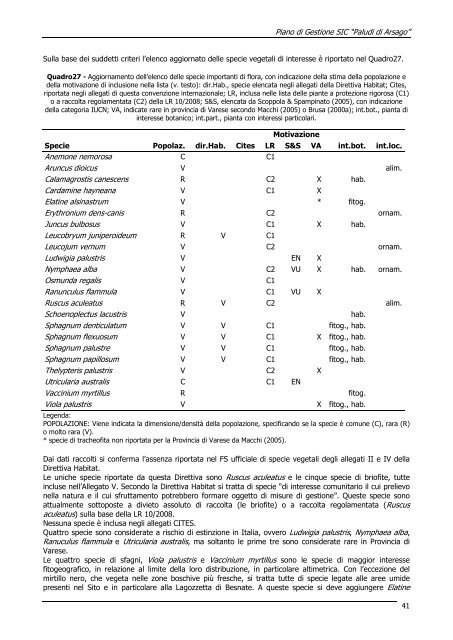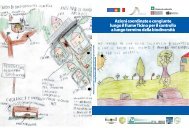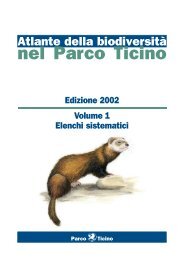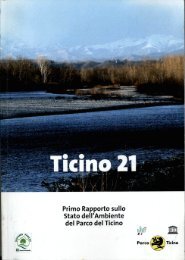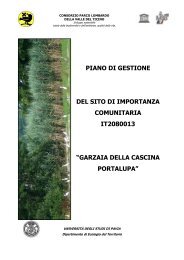Paludi di Arsago - Delizie del Ticino - Parco del Ticino
Paludi di Arsago - Delizie del Ticino - Parco del Ticino
Paludi di Arsago - Delizie del Ticino - Parco del Ticino
You also want an ePaper? Increase the reach of your titles
YUMPU automatically turns print PDFs into web optimized ePapers that Google loves.
Piano <strong>di</strong> Gestione SIC “<strong>Palu<strong>di</strong></strong> <strong>di</strong> <strong>Arsago</strong>”<br />
Sulla base dei suddetti criteri l’elenco aggiornato <strong>del</strong>le specie vegetali <strong>di</strong> interesse è riportato nel Quadro27.<br />
Quadro27 - Aggiornamento <strong>del</strong>l’elenco <strong>del</strong>le specie importanti <strong>di</strong> flora, con in<strong>di</strong>cazione <strong>del</strong>la stima <strong>del</strong>la popolazione e<br />
<strong>del</strong>la motivazione <strong>di</strong> inclusione nella lista (v. testo): <strong>di</strong>r.Hab., specie elencata negli allegati <strong>del</strong>la Direttiva Habitat; Cites,<br />
riportata negli allegati <strong>di</strong> questa convenzione internazionale; LR, inclusa nelle lista <strong>del</strong>le piante a protezione rigorosa (C1)<br />
o a raccolta regolamentata (C2) <strong>del</strong>la LR 10/2008; S&S, elencata da Scoppola & Spampinato (2005), con in<strong>di</strong>cazione<br />
<strong>del</strong>la categoria IUCN; VA, in<strong>di</strong>cate rare in provincia <strong>di</strong> Varese secondo Macchi (2005) o Brusa (2000a); int.bot., pianta <strong>di</strong><br />
interesse botanico; int.part., pianta con interessi particolari.<br />
Motivazione<br />
Specie Popolaz. <strong>di</strong>r.Hab. Cites LR S&S VA int.bot. int.loc.<br />
Anemone nemorosa C C1<br />
Aruncus <strong>di</strong>oicus V alim.<br />
Calamagrostis canescens R C2 X hab.<br />
Cardamine hayneana V C1 X<br />
Elatine alsinastrum V * fitog.<br />
Erythronium dens-canis R C2 ornam.<br />
Juncus bulbosus V C1 X hab.<br />
Leucobryum juniperoideum R V C1<br />
Leucojum vernum V C2 ornam.<br />
Ludwigia palustris V EN X<br />
Nymphaea alba V C2 VU X hab. ornam.<br />
Osmunda regalis V C1<br />
Ranunculus flammula V C1 VU X<br />
Ruscus aculeatus R V C2 alim.<br />
Schoenoplectus lacustris V hab.<br />
Sphagnum denticulatum V V C1 fitog., hab.<br />
Sphagnum flexuosum V V C1 X fitog., hab.<br />
Sphagnum palustre V V C1 fitog., hab.<br />
Sphagnum papillosum V V C1 fitog., hab.<br />
Thelypteris palustris V C2 X<br />
Utricularia australis C C1 EN<br />
Vaccinium myrtillus R fitog.<br />
Viola palustris V X fitog., hab.<br />
Legenda:<br />
POPOLAZIONE: Viene in<strong>di</strong>cata la <strong>di</strong>mensione/densità <strong>del</strong>la popolazione, specificando se la specie è comune (C), rara (R)<br />
o molto rara (V).<br />
* specie <strong>di</strong> tracheofita non riportata per la Provincia <strong>di</strong> Varese da Macchi (2005).<br />
Dai dati raccolti si conferma l’assenza riportata nel FS ufficiale <strong>di</strong> specie vegetali degli allegati II e IV <strong>del</strong>la<br />
Direttiva Habitat.<br />
Le uniche specie riportate da questa Direttiva sono Ruscus aculeatus e le cinque specie <strong>di</strong> briofite, tutte<br />
incluse nell’Allegato V. Secondo la Direttiva Habitat si tratta <strong>di</strong> specie “<strong>di</strong> interesse comunitario il cui prelievo<br />
nella natura e il cui sfruttamento potrebbero formare oggetto <strong>di</strong> misure <strong>di</strong> gestione”. Queste specie sono<br />
attualmente sottoposte a <strong>di</strong>vieto assoluto <strong>di</strong> raccolta (le briofite) o a raccolta regolamentata (Ruscus<br />
aculeatus) sulla base <strong>del</strong>la LR 10/2008.<br />
Nessuna specie è inclusa negli allegati CITES.<br />
Quattro specie sono considerate a rischio <strong>di</strong> estinzione in Italia, ovvero Ludwigia palustris, Nymphaea alba,<br />
Ranuculus flammula e Utricularia australis, ma soltanto le prime tre sono considerate rare in Provincia <strong>di</strong><br />
Varese.<br />
Le quattro specie <strong>di</strong> sfagni, Viola palustris e Vaccinium myrtillus sono le specie <strong>di</strong> maggior interesse<br />
fitogeografico, in relazione al limite <strong>del</strong>la loro <strong>di</strong>stribuzione, in particolare altimetrica. Con l’eccezione <strong>del</strong><br />
mirtillo nero, che vegeta nelle zone boschive più fresche, si tratta tutte <strong>di</strong> specie legate alle aree umide<br />
presenti nel Sito e in particolare alla Lagozzetta <strong>di</strong> Besnate. A queste specie si deve aggiungere Elatine<br />
41


